HOW THE WORLD REALLY WORKS
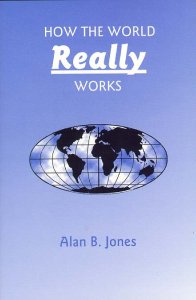 More
and more Americans are coming to feel that something has gone fundamentally
wrong in our society. We have suffered repetitive wars, big and small,
some won and some lost, but with the peace always lost. Our society has
been drained of around $5 trillion in welfare costs since LBJ's War on
Poverty was declared, but with no diminution in the incidence of "poverty."
Our "War on Drugs" has also been lost, with its societal costs running
around $500 billion per year. The cost of fixes for runaway environmentalism
has reached about $1 trillion since the birth of the EPA in 1970. Our national
debt is over $5 trillion and still going up. Two breadwinners per family
has become normal, just to keep bread on the table.
More
and more Americans are coming to feel that something has gone fundamentally
wrong in our society. We have suffered repetitive wars, big and small,
some won and some lost, but with the peace always lost. Our society has
been drained of around $5 trillion in welfare costs since LBJ's War on
Poverty was declared, but with no diminution in the incidence of "poverty."
Our "War on Drugs" has also been lost, with its societal costs running
around $500 billion per year. The cost of fixes for runaway environmentalism
has reached about $1 trillion since the birth of the EPA in 1970. Our national
debt is over $5 trillion and still going up. Two breadwinners per family
has become normal, just to keep bread on the table.
Americans feel put upon, and they are right, but they
don't know who's doing it to them or why. Such issues have been pondered
by researchers for many years, but the historical facts are finally bringing
the pieces of the puzzle together. This book paints a picture of that largely
completed puzzle, and lays out who the culprits are, why
they are doing what they are doing, and how they are managing
to pull off what is probably the biggest mass robbery of wealth and individual
freedom in human history. Your reading this book will help to expose and
stop the destruction, and help to guarantee a future of freedom rather
than slavery for your children.
The picture which our book paints is one which you must
understand if your efforts are ever to amount to anything. We paint that
picture by presenting an ordered set of book reviews which identify our
enemies and describe the primary strategies and actions which they have
taken against us over the last 100 years or so. Our goal in writing the
book was to provide an accurate portrayal of that picture within the covers
of a single moderate- length book. The 12 chapter
titles of How The World Really Works are listed below, and
consist of the names of the books being reviewed.
.
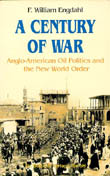 1.
A Century of War, by William Engdahl, 1993.
Engdahl summarizes the horrors of the 20th Century, including two World
Wars, a stock market crash and subsequent depression, the rise of Hitler,
the formation of the Seven Sisters oil cartel, the Green movement, the
slowdown of industrial growth, the bankrupting of the Third World, and
much more.
1.
A Century of War, by William Engdahl, 1993.
Engdahl summarizes the horrors of the 20th Century, including two World
Wars, a stock market crash and subsequent depression, the rise of Hitler,
the formation of the Seven Sisters oil cartel, the Green movement, the
slowdown of industrial growth, the bankrupting of the Third World, and
much more.
�
�
�
�
.
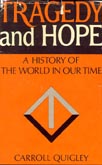 2.
Tragedy and Hope, by Carroll Quigley, 1966.
In this 1300-page book, Professor Quigley, having been given access to
the private records of the "Insiders," spills the beans about the identity
(Rothschild, Morgan, etc.) and the world-wide works of those Insider elites.
To his surprise, the Establishment was not pleased by his book, and tried
to suppress it. Its publication was a watershed event in our struggle to
understand who was running the world. For example, our chapter discusses,
among many other things, Quigley's account of how and why the British leadership
supported the rise of Adolph Hitler in the 1930's.
2.
Tragedy and Hope, by Carroll Quigley, 1966.
In this 1300-page book, Professor Quigley, having been given access to
the private records of the "Insiders," spills the beans about the identity
(Rothschild, Morgan, etc.) and the world-wide works of those Insider elites.
To his surprise, the Establishment was not pleased by his book, and tried
to suppress it. Its publication was a watershed event in our struggle to
understand who was running the world. For example, our chapter discusses,
among many other things, Quigley's account of how and why the British leadership
supported the rise of Adolph Hitler in the 1930's.
�
.
 3.
The Naked Capitalist, by W. Cleon Skousen,
1970. This was the first well-known book to plumb the depths of Quigley's
opus and present what was found for the benefit of us ordinary folk. Skousen
searches for and discusses the apparent motivations of the elites, their
relation to the world-wide socialist and communist movements, their use
of the major tax-exempt foundations, their creation of the CFR and the
Bilderberger group, and the primary objective of their conspiracy � to
subjugate the American Middle Class.
3.
The Naked Capitalist, by W. Cleon Skousen,
1970. This was the first well-known book to plumb the depths of Quigley's
opus and present what was found for the benefit of us ordinary folk. Skousen
searches for and discusses the apparent motivations of the elites, their
relation to the world-wide socialist and communist movements, their use
of the major tax-exempt foundations, their creation of the CFR and the
Bilderberger group, and the primary objective of their conspiracy � to
subjugate the American Middle Class.
�
�
.
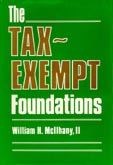 4.
The Tax-Exempt Foundations, by William H.
McIlhany, II, 1980. When this was written, the elites had already spent
60 years or so in acquiring a stranglehold on the American education system
and misdirecting it to collectivist ends. This book tells the tale, featuring
the testimony of Norman Dodd, the chief investigator of the 1954 Reece
Committee investigating the incestuous ties between government, education,
and the major foundations. The hearings were forcibly aborted, but this
book preserves the highly important major findings.
4.
The Tax-Exempt Foundations, by William H.
McIlhany, II, 1980. When this was written, the elites had already spent
60 years or so in acquiring a stranglehold on the American education system
and misdirecting it to collectivist ends. This book tells the tale, featuring
the testimony of Norman Dodd, the chief investigator of the 1954 Reece
Committee investigating the incestuous ties between government, education,
and the major foundations. The hearings were forcibly aborted, but this
book preserves the highly important major findings.
�
�
.
 5.
The Creature From Jekyll Island, by G. Edward
Griffin, 1994. You must acquire this book, though it runs to some
600 pages. It tells the story of the conspiratorial creation of the Federal
Reserve, its real purposes, its methodology for enabling government
to spend money it doesn't have and couldn't otherwise get, its love and
perverse utilization of warfare, its role and purpose in creating the inflation
of the "roaring 20s" and in subsequently instigating the stock market crash,
its role in and purpose for bankrupting the Third World, and its many other
activities aimed at giving aid and comfort to the international elites.
Our book tries to hit the high spots.
5.
The Creature From Jekyll Island, by G. Edward
Griffin, 1994. You must acquire this book, though it runs to some
600 pages. It tells the story of the conspiratorial creation of the Federal
Reserve, its real purposes, its methodology for enabling government
to spend money it doesn't have and couldn't otherwise get, its love and
perverse utilization of warfare, its role and purpose in creating the inflation
of the "roaring 20s" and in subsequently instigating the stock market crash,
its role in and purpose for bankrupting the Third World, and its many other
activities aimed at giving aid and comfort to the international elites.
Our book tries to hit the high spots.
�
.
 6.
1984, by George Orwell, 1949. This classic
by English Socialist Eric Blair, under the pen name George Orwell, reveals
why
an elite would want to subjugate its own middle and lower classes, and
how that goal might be attained so as to remain a permanent system, forever.
It may have been written as just a novel, but lots of the elements for
permanent control are already in place. The purposes of war, of middle-class
impoverishment, of third-world depopulation and slavery, and of media control
are all laid out. We watch, fascinated, as its written plan for permanent
control via a New World Order takes place in the real world before our
very eyes. 1984 is an essential piece of the picture we are
painting of how the world really works.
6.
1984, by George Orwell, 1949. This classic
by English Socialist Eric Blair, under the pen name George Orwell, reveals
why
an elite would want to subjugate its own middle and lower classes, and
how that goal might be attained so as to remain a permanent system, forever.
It may have been written as just a novel, but lots of the elements for
permanent control are already in place. The purposes of war, of middle-class
impoverishment, of third-world depopulation and slavery, and of media control
are all laid out. We watch, fascinated, as its written plan for permanent
control via a New World Order takes place in the real world before our
very eyes. 1984 is an essential piece of the picture we are
painting of how the world really works.
�
.
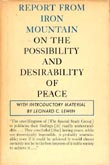 7.
Report From Iron Mountain, foreword by Leonard
Lewin, 1967. This famous report, allegedly commissioned by some high agency
of the federal government, asked a set of establishmentarian social scientists
how the country could survive if peace were suddenly declared. What would
suffice to replace war? Not many things, said the study, except maybe rampant
environmentalism added to vastly expanded welfarism, though even these
activities did not seem to have the potential for producing sufficient
economic waste, and maybe we would have to stick with war for a while longer.
This book verifies the elite mind-set described in 1984,
and leads directly to our next chapter.
7.
Report From Iron Mountain, foreword by Leonard
Lewin, 1967. This famous report, allegedly commissioned by some high agency
of the federal government, asked a set of establishmentarian social scientists
how the country could survive if peace were suddenly declared. What would
suffice to replace war? Not many things, said the study, except maybe rampant
environmentalism added to vastly expanded welfarism, though even these
activities did not seem to have the potential for producing sufficient
economic waste, and maybe we would have to stick with war for a while longer.
This book verifies the elite mind-set described in 1984,
and leads directly to our next chapter.
�
.
 8.
The Greening, by Larry Abraham, 1993. Abraham
outlines how the environmentalism suggested by the Iron Mountain gurus
has been implemented in the subsequent 25 years. Beyond simply generating
economic waste, he outlines its much more important goal, which has to
do with delivering much of the world's physical resources into the hands
of our wannabe masters. Extremely important.
8.
The Greening, by Larry Abraham, 1993. Abraham
outlines how the environmentalism suggested by the Iron Mountain gurus
has been implemented in the subsequent 25 years. Beyond simply generating
economic waste, he outlines its much more important goal, which has to
do with delivering much of the world's physical resources into the hands
of our wannabe masters. Extremely important.
�
�
�
�
.
 9.
The Politics of Heroin, by Alfred M. McCoy,
1991. This book is sub-titled CIA Complicity in the Global Drug Trade.
While current investigations into this topic relate to the cocaine trade
within our own hemisphere, Professor McCoy's book deals with prior CIA
involvement in Marseille in the 40's and 50's, in the Golden Triangle during
the Vietnam War, and in Afghanistan during the 80's. We begin to understand
why government is not seriously dedicated to stopping the traffic in addictive
drugs.
9.
The Politics of Heroin, by Alfred M. McCoy,
1991. This book is sub-titled CIA Complicity in the Global Drug Trade.
While current investigations into this topic relate to the cocaine trade
within our own hemisphere, Professor McCoy's book deals with prior CIA
involvement in Marseille in the 40's and 50's, in the Golden Triangle during
the Vietnam War, and in Afghanistan during the 80's. We begin to understand
why government is not seriously dedicated to stopping the traffic in addictive
drugs.
�
�
.
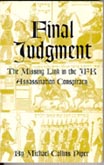 10.
Final Judgment, by Michael Collins Piper,
1995. We pick from this book the common ties among the world's major secret
intelligence agencies, the ties of those agencies to the world's organized
crime rings, and the strained relations between President John F. Kennedy
and those various intelligence and crime entities. The book rationally
ties together the known facts about JFK's assassination, and reveals the
extent of the ties between the elites and the providers of organized mayhem
throughout the world. The establishment is giving this book the silent
treatment.
10.
Final Judgment, by Michael Collins Piper,
1995. We pick from this book the common ties among the world's major secret
intelligence agencies, the ties of those agencies to the world's organized
crime rings, and the strained relations between President John F. Kennedy
and those various intelligence and crime entities. The book rationally
ties together the known facts about JFK's assassination, and reveals the
extent of the ties between the elites and the providers of organized mayhem
throughout the world. The establishment is giving this book the silent
treatment.
�
�
.
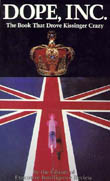 11.
Dope, Inc., by the Executive Intelligence
Review, 1992 (3rd ed.). This 650-page book traces the history of drug trafficking
over the last two hundred years or so, naming a lot of names in both Europe
and the United States. The center of the hydra which is promoting the traffic,
profiting from it, and protecting and expanding the trade via its control
over the important crime and intelligence agencies around the world, is
clearly spelled out. The illicit drug industry is one of the primary tools
of our enemies, which weakens us while it raises revenue and private armed
forces for them. We relate in our chapter many of the important highlights,
which are seen to provide the last essential missing pieces of the puzzle
which we have attempted to assemble and present.
11.
Dope, Inc., by the Executive Intelligence
Review, 1992 (3rd ed.). This 650-page book traces the history of drug trafficking
over the last two hundred years or so, naming a lot of names in both Europe
and the United States. The center of the hydra which is promoting the traffic,
profiting from it, and protecting and expanding the trade via its control
over the important crime and intelligence agencies around the world, is
clearly spelled out. The illicit drug industry is one of the primary tools
of our enemies, which weakens us while it raises revenue and private armed
forces for them. We relate in our chapter many of the important highlights,
which are seen to provide the last essential missing pieces of the puzzle
which we have attempted to assemble and present.
�
.
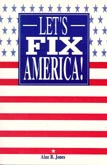 12.
Let's Fix America, by Alan B. Jones, 1994.
This is our own book, written just before How The World Really Works.
In the present Chapter 12 of How The World Really Works,
we reviewed the LFA proposals, kept many of them as they stood, but strengthened
or added a few more, where the need had become obvious. For example, much
stronger action was found necessary in the area of defeating the drug scourge,
and in our trade and other foreign policy matters which severely impact
our economic and societal well-being. As a revised set of actions, we propose
to:
12.
Let's Fix America, by Alan B. Jones, 1994.
This is our own book, written just before How The World Really Works.
In the present Chapter 12 of How The World Really Works,
we reviewed the LFA proposals, kept many of them as they stood, but strengthened
or added a few more, where the need had become obvious. For example, much
stronger action was found necessary in the area of defeating the drug scourge,
and in our trade and other foreign policy matters which severely impact
our economic and societal well-being. As a revised set of actions, we propose
to:
�
-
Abolish the Fed and return to an honest gold standard.
-
Force the federal budget into balance, and thereby stop inflation.
-
Force the permanent reduction of the tax load to a tolerable
level.
-
Replace the IRS, the income tax, and the 16th Amendment with
a sales tax on sold goods and services.
-
Phase the federal government out of the pension business
(Social Security).
-
Phase the federal government out of the medical insurance
business (Medicare).
-
Phase the federal government out of the welfare business
(AFDC, food stamps, etc.).
-
Attack drug trafficking in earnest. To take the profit out
of the trade, allow states to sell low-cost, pure drugs to medically certified
addicts (only), and then jail the directors of banks caught laundering
drug money.
-
Empower parents to choose what schools their own kids will
attend.
-
Reduce crime via the welfare, drug, and education reforms
described above.
-
Reform liability litigation to force judgments to match valuatable
losses.
-
Remove the abortion issue from the (unconstitutionally assumed)
jurisdiction of the federal courts.
-
Permit states to help identify and hold illegal immigrants
for deportation, and expedite that latter action.
-
Remove our country from elite-controlled international agencies
(UN, IMF, World Bank, etc.), reclaim Senate jurisdiction over the details
of trade agreements, and discourage overseas investment of the kind or
in amounts which detract from the adequate maintenance of our own country
and society.
-
Force Congress to adhere to the intent and the words of our
Tenth Amendment.
-
Get our own government to acknowledge to our citizenry that
our American society is under attack, and has been for many years, and
that the government and the citizenry are going to henceforth cooperate
to repel that attack.
.
Link to Home Page, LFA
Page, HTW Page, SOF
Page, RPH Page, RAF
Page, or Links Page.
* * *
 More
and more Americans are coming to feel that something has gone fundamentally
wrong in our society. We have suffered repetitive wars, big and small,
some won and some lost, but with the peace always lost. Our society has
been drained of around $5 trillion in welfare costs since LBJ's War on
Poverty was declared, but with no diminution in the incidence of "poverty."
Our "War on Drugs" has also been lost, with its societal costs running
around $500 billion per year. The cost of fixes for runaway environmentalism
has reached about $1 trillion since the birth of the EPA in 1970. Our national
debt is over $5 trillion and still going up. Two breadwinners per family
has become normal, just to keep bread on the table.
More
and more Americans are coming to feel that something has gone fundamentally
wrong in our society. We have suffered repetitive wars, big and small,
some won and some lost, but with the peace always lost. Our society has
been drained of around $5 trillion in welfare costs since LBJ's War on
Poverty was declared, but with no diminution in the incidence of "poverty."
Our "War on Drugs" has also been lost, with its societal costs running
around $500 billion per year. The cost of fixes for runaway environmentalism
has reached about $1 trillion since the birth of the EPA in 1970. Our national
debt is over $5 trillion and still going up. Two breadwinners per family
has become normal, just to keep bread on the table.
 1.
A Century of War, by William Engdahl, 1993.
Engdahl summarizes the horrors of the 20th Century, including two World
Wars, a stock market crash and subsequent depression, the rise of Hitler,
the formation of the Seven Sisters oil cartel, the Green movement, the
slowdown of industrial growth, the bankrupting of the Third World, and
much more.
1.
A Century of War, by William Engdahl, 1993.
Engdahl summarizes the horrors of the 20th Century, including two World
Wars, a stock market crash and subsequent depression, the rise of Hitler,
the formation of the Seven Sisters oil cartel, the Green movement, the
slowdown of industrial growth, the bankrupting of the Third World, and
much more.
 2.
Tragedy and Hope, by Carroll Quigley, 1966.
In this 1300-page book, Professor Quigley, having been given access to
the private records of the "Insiders," spills the beans about the identity
(Rothschild, Morgan, etc.) and the world-wide works of those Insider elites.
To his surprise, the Establishment was not pleased by his book, and tried
to suppress it. Its publication was a watershed event in our struggle to
understand who was running the world. For example, our chapter discusses,
among many other things, Quigley's account of how and why the British leadership
supported the rise of Adolph Hitler in the 1930's.
2.
Tragedy and Hope, by Carroll Quigley, 1966.
In this 1300-page book, Professor Quigley, having been given access to
the private records of the "Insiders," spills the beans about the identity
(Rothschild, Morgan, etc.) and the world-wide works of those Insider elites.
To his surprise, the Establishment was not pleased by his book, and tried
to suppress it. Its publication was a watershed event in our struggle to
understand who was running the world. For example, our chapter discusses,
among many other things, Quigley's account of how and why the British leadership
supported the rise of Adolph Hitler in the 1930's.
 3.
The Naked Capitalist, by W. Cleon Skousen,
1970. This was the first well-known book to plumb the depths of Quigley's
opus and present what was found for the benefit of us ordinary folk. Skousen
searches for and discusses the apparent motivations of the elites, their
relation to the world-wide socialist and communist movements, their use
of the major tax-exempt foundations, their creation of the CFR and the
Bilderberger group, and the primary objective of their conspiracy � to
subjugate the American Middle Class.
3.
The Naked Capitalist, by W. Cleon Skousen,
1970. This was the first well-known book to plumb the depths of Quigley's
opus and present what was found for the benefit of us ordinary folk. Skousen
searches for and discusses the apparent motivations of the elites, their
relation to the world-wide socialist and communist movements, their use
of the major tax-exempt foundations, their creation of the CFR and the
Bilderberger group, and the primary objective of their conspiracy � to
subjugate the American Middle Class.
 4.
The Tax-Exempt Foundations, by William H.
McIlhany, II, 1980. When this was written, the elites had already spent
60 years or so in acquiring a stranglehold on the American education system
and misdirecting it to collectivist ends. This book tells the tale, featuring
the testimony of Norman Dodd, the chief investigator of the 1954 Reece
Committee investigating the incestuous ties between government, education,
and the major foundations. The hearings were forcibly aborted, but this
book preserves the highly important major findings.
4.
The Tax-Exempt Foundations, by William H.
McIlhany, II, 1980. When this was written, the elites had already spent
60 years or so in acquiring a stranglehold on the American education system
and misdirecting it to collectivist ends. This book tells the tale, featuring
the testimony of Norman Dodd, the chief investigator of the 1954 Reece
Committee investigating the incestuous ties between government, education,
and the major foundations. The hearings were forcibly aborted, but this
book preserves the highly important major findings.
 5.
The Creature From Jekyll Island, by G. Edward
Griffin, 1994. You must acquire this book, though it runs to some
600 pages. It tells the story of the conspiratorial creation of the Federal
Reserve, its real purposes, its methodology for enabling government
to spend money it doesn't have and couldn't otherwise get, its love and
perverse utilization of warfare, its role and purpose in creating the inflation
of the "roaring 20s" and in subsequently instigating the stock market crash,
its role in and purpose for bankrupting the Third World, and its many other
activities aimed at giving aid and comfort to the international elites.
Our book tries to hit the high spots.
5.
The Creature From Jekyll Island, by G. Edward
Griffin, 1994. You must acquire this book, though it runs to some
600 pages. It tells the story of the conspiratorial creation of the Federal
Reserve, its real purposes, its methodology for enabling government
to spend money it doesn't have and couldn't otherwise get, its love and
perverse utilization of warfare, its role and purpose in creating the inflation
of the "roaring 20s" and in subsequently instigating the stock market crash,
its role in and purpose for bankrupting the Third World, and its many other
activities aimed at giving aid and comfort to the international elites.
Our book tries to hit the high spots.
 6.
1984, by George Orwell, 1949. This classic
by English Socialist Eric Blair, under the pen name George Orwell, reveals
why
an elite would want to subjugate its own middle and lower classes, and
how that goal might be attained so as to remain a permanent system, forever.
It may have been written as just a novel, but lots of the elements for
permanent control are already in place. The purposes of war, of middle-class
impoverishment, of third-world depopulation and slavery, and of media control
are all laid out. We watch, fascinated, as its written plan for permanent
control via a New World Order takes place in the real world before our
very eyes. 1984 is an essential piece of the picture we are
painting of how the world really works.
6.
1984, by George Orwell, 1949. This classic
by English Socialist Eric Blair, under the pen name George Orwell, reveals
why
an elite would want to subjugate its own middle and lower classes, and
how that goal might be attained so as to remain a permanent system, forever.
It may have been written as just a novel, but lots of the elements for
permanent control are already in place. The purposes of war, of middle-class
impoverishment, of third-world depopulation and slavery, and of media control
are all laid out. We watch, fascinated, as its written plan for permanent
control via a New World Order takes place in the real world before our
very eyes. 1984 is an essential piece of the picture we are
painting of how the world really works.
 7.
Report From Iron Mountain, foreword by Leonard
Lewin, 1967. This famous report, allegedly commissioned by some high agency
of the federal government, asked a set of establishmentarian social scientists
how the country could survive if peace were suddenly declared. What would
suffice to replace war? Not many things, said the study, except maybe rampant
environmentalism added to vastly expanded welfarism, though even these
activities did not seem to have the potential for producing sufficient
economic waste, and maybe we would have to stick with war for a while longer.
This book verifies the elite mind-set described in 1984,
and leads directly to our next chapter.
7.
Report From Iron Mountain, foreword by Leonard
Lewin, 1967. This famous report, allegedly commissioned by some high agency
of the federal government, asked a set of establishmentarian social scientists
how the country could survive if peace were suddenly declared. What would
suffice to replace war? Not many things, said the study, except maybe rampant
environmentalism added to vastly expanded welfarism, though even these
activities did not seem to have the potential for producing sufficient
economic waste, and maybe we would have to stick with war for a while longer.
This book verifies the elite mind-set described in 1984,
and leads directly to our next chapter.
 8.
The Greening, by Larry Abraham, 1993. Abraham
outlines how the environmentalism suggested by the Iron Mountain gurus
has been implemented in the subsequent 25 years. Beyond simply generating
economic waste, he outlines its much more important goal, which has to
do with delivering much of the world's physical resources into the hands
of our wannabe masters. Extremely important.
8.
The Greening, by Larry Abraham, 1993. Abraham
outlines how the environmentalism suggested by the Iron Mountain gurus
has been implemented in the subsequent 25 years. Beyond simply generating
economic waste, he outlines its much more important goal, which has to
do with delivering much of the world's physical resources into the hands
of our wannabe masters. Extremely important.
 9.
The Politics of Heroin, by Alfred M. McCoy,
1991. This book is sub-titled CIA Complicity in the Global Drug Trade.
While current investigations into this topic relate to the cocaine trade
within our own hemisphere, Professor McCoy's book deals with prior CIA
involvement in Marseille in the 40's and 50's, in the Golden Triangle during
the Vietnam War, and in Afghanistan during the 80's. We begin to understand
why government is not seriously dedicated to stopping the traffic in addictive
drugs.
9.
The Politics of Heroin, by Alfred M. McCoy,
1991. This book is sub-titled CIA Complicity in the Global Drug Trade.
While current investigations into this topic relate to the cocaine trade
within our own hemisphere, Professor McCoy's book deals with prior CIA
involvement in Marseille in the 40's and 50's, in the Golden Triangle during
the Vietnam War, and in Afghanistan during the 80's. We begin to understand
why government is not seriously dedicated to stopping the traffic in addictive
drugs.
 10.
Final Judgment, by Michael Collins Piper,
1995. We pick from this book the common ties among the world's major secret
intelligence agencies, the ties of those agencies to the world's organized
crime rings, and the strained relations between President John F. Kennedy
and those various intelligence and crime entities. The book rationally
ties together the known facts about JFK's assassination, and reveals the
extent of the ties between the elites and the providers of organized mayhem
throughout the world. The establishment is giving this book the silent
treatment.
10.
Final Judgment, by Michael Collins Piper,
1995. We pick from this book the common ties among the world's major secret
intelligence agencies, the ties of those agencies to the world's organized
crime rings, and the strained relations between President John F. Kennedy
and those various intelligence and crime entities. The book rationally
ties together the known facts about JFK's assassination, and reveals the
extent of the ties between the elites and the providers of organized mayhem
throughout the world. The establishment is giving this book the silent
treatment.
 11.
Dope, Inc., by the Executive Intelligence
Review, 1992 (3rd ed.). This 650-page book traces the history of drug trafficking
over the last two hundred years or so, naming a lot of names in both Europe
and the United States. The center of the hydra which is promoting the traffic,
profiting from it, and protecting and expanding the trade via its control
over the important crime and intelligence agencies around the world, is
clearly spelled out. The illicit drug industry is one of the primary tools
of our enemies, which weakens us while it raises revenue and private armed
forces for them. We relate in our chapter many of the important highlights,
which are seen to provide the last essential missing pieces of the puzzle
which we have attempted to assemble and present.
11.
Dope, Inc., by the Executive Intelligence
Review, 1992 (3rd ed.). This 650-page book traces the history of drug trafficking
over the last two hundred years or so, naming a lot of names in both Europe
and the United States. The center of the hydra which is promoting the traffic,
profiting from it, and protecting and expanding the trade via its control
over the important crime and intelligence agencies around the world, is
clearly spelled out. The illicit drug industry is one of the primary tools
of our enemies, which weakens us while it raises revenue and private armed
forces for them. We relate in our chapter many of the important highlights,
which are seen to provide the last essential missing pieces of the puzzle
which we have attempted to assemble and present.
 12.
Let's Fix America, by Alan B. Jones, 1994.
This is our own book, written just before How The World Really Works.
In the present Chapter 12 of How The World Really Works,
we reviewed the LFA proposals, kept many of them as they stood, but strengthened
or added a few more, where the need had become obvious. For example, much
stronger action was found necessary in the area of defeating the drug scourge,
and in our trade and other foreign policy matters which severely impact
our economic and societal well-being. As a revised set of actions, we propose
to:
12.
Let's Fix America, by Alan B. Jones, 1994.
This is our own book, written just before How The World Really Works.
In the present Chapter 12 of How The World Really Works,
we reviewed the LFA proposals, kept many of them as they stood, but strengthened
or added a few more, where the need had become obvious. For example, much
stronger action was found necessary in the area of defeating the drug scourge,
and in our trade and other foreign policy matters which severely impact
our economic and societal well-being. As a revised set of actions, we propose
to: